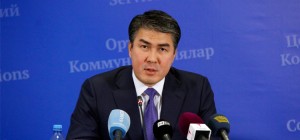ASTANA – An export policy that provides direction to reorient domestic products to new markets has been developed bythe Kazakh Ministry for Investment and Development.
“Despite the reductionin exportsbased on external factors, exports as a wholeand the reduced supply of raw materials, there is a decline in exports of processed goods, but exports of manufactured goods remained at the same level – $4 billion. As you may recall, in 2010 the export of finished products was $2 billion andin 2014 it doubled despite serious impacts,” said Minister for Investment and Development Asset Issekeshev during a Feb. 17 briefing at the Central Communications Service.
Despite the economic challenges more than 770 projects were launched in the framework of the Industrialisation Map programme, of which 15 percent, or more than 100 companies, have begun exporting their products worth $1 billion, he added.
“It is too early to speak about serious success. There is plenty of work ahead, but still the policy of industrialisation of our President has helped to keep the current volumes, especially of finished products, and to increase exports of products with high added value,” said Issekeshev.
The minister also stressed that many businesses in the northern areas of the country are focused on the Russian market and that there are now certain difficulties due to the devaluation of the ruble. Yet the government has decided to start the new export policy developed by the ministry.
“We need to look again at reorientation of exports from a shrinking market to new markets such as Central Asia, the Caucasus, Iran and Asia as a whole. Trade missions to Turkmenistan, Kyrgyzstan, Mongolia, Turkey and other countries are planned in February, March and April. New offices of the KAZNEX agency for export and investment will be opened in Novosibirsk and Tehran to support exporters on the ground,” said Issekeshev.
In addition, 20 projects will be introduced in special economic zones (SEZ) this year. Of these, the most interesting is the production of diesel engines in the Astana – New City SEZ. A petrochemical cluster in the Atyrau region is also due to start this year.
“Production of polyethylene film, aromatic hydrocarbons and food film is beginning. In addition, Ataryu will start production of large oil and gas equipment. Also due to start is the construction of the first phase of a gas chemical complex for the production of polypropylene,” said the head of the ministry.
A programme is also continuing with China that has about 40 projects in the works, of which 20 are expected to sign specific agreements in March.
“The total volume of the agreements, which we plan to sign in March, is worth more than $18 billion. In 2015, the ministry will focus on two main areas and exceptional systemic measures. First, we will continue to negotiate with investors who intend to participate in the implementation of the second five-year plan for the priority sectors of the economy. There are about 100 companies with investments of more than $40 million. Sixty of them are already working within the framework of the Industrialisation Map. We are planning to sign investment contracts for a new set of preferences with 10 of them,” said Issekeshev.



